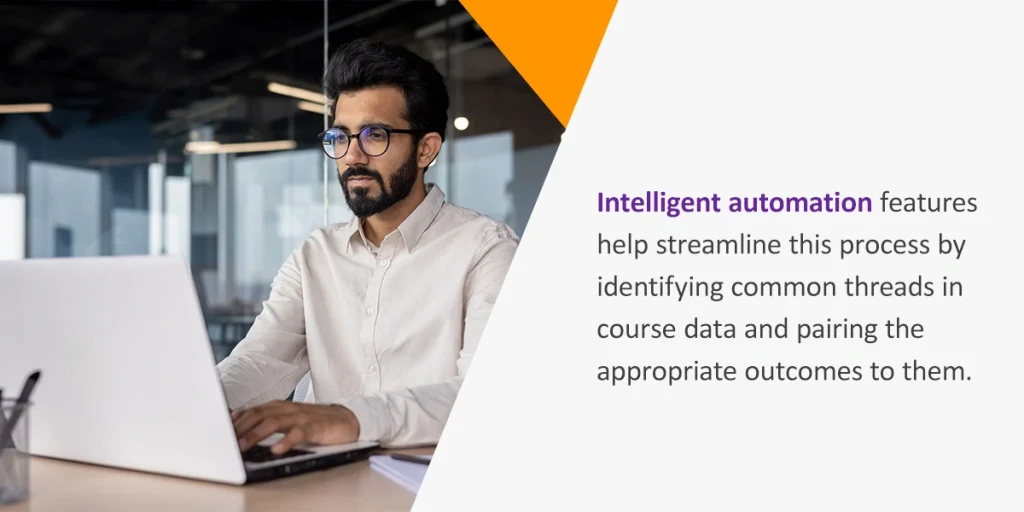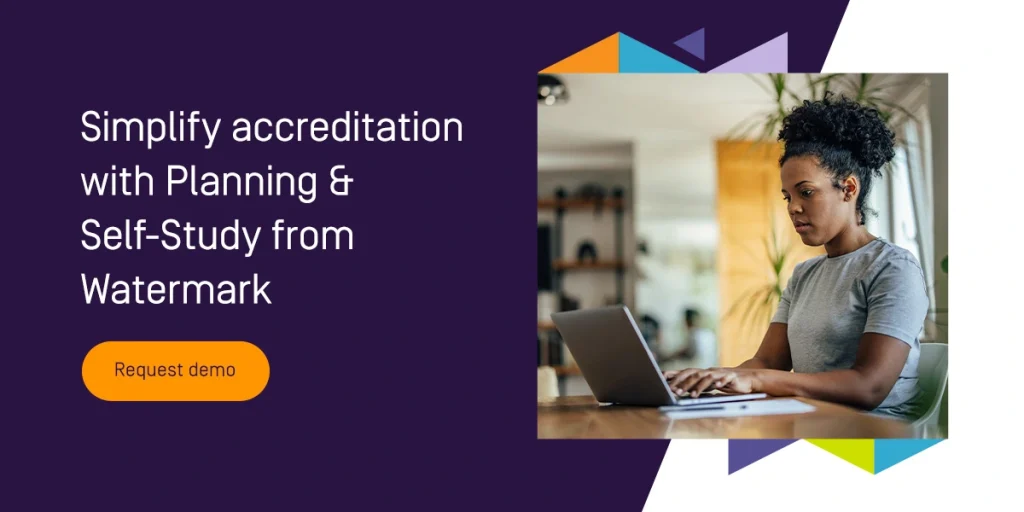




When your accreditors assess your institution, you need to make sure you dot all your I’s and cross all your T’s. That work starts during the planning and self-study process.
When you’re using disparate legacy systems to store departmental and institutional data, though, it’s difficult to complete tasks like self-studies and departmental reviews on time. Using the right tools can help eliminate some of the most common accreditation prep headaches.
Self-study is a critical component in accreditation preparation where both academic and non-academic departments reflect on their strengths and weaknesses. Some of the typical criteria in a self-study include:
Whether you’re preparing for the initial accreditation assessment or an upcoming reevaluation, quality program data is critical for a thorough review. Advanced higher education data analytics software equipped with intelligent automation can help you quickly generate actionable insights into where each department can improve and how.
Implementing the right curriculum planning and self-study tools in your institution can save faculty members valuable time in generating reports and identifying areas for improvement.
Here are some of the ways an advanced planning and self-study software can help you streamline accreditation preparation:
You need to keep your most important stakeholders in the loop during the accreditation process, as their support is essential for your institution’s success. From students to faculty to the board of trustees, you need to ensure everyone has a role that aligns with your institution’s mission and strategic plan.
A planning and self-study software with the ability to share your strategic plan with stakeholders both inside and outside the institution makes it easier to keep them updated any time a department changes curriculum elements. This commitment to openness is critical. When stakeholders feel that your institution is being honest and transparent about the changes you make and the rationale behind them, they’re more likely to continue supporting you.
Although our culture tends to romanticize the value of listening to your intuition, it’s usually better to turn to the facts first. Data-driven decision-making helps leaders make sound decisions that are grounded in truth — which is essential for ensuring your institution stays competitive amid the coming enrollment decline.
Planning and self-study software provides a centralized hub for all your data, so each department has a single source of truth that reflects the entire institution. Any time one group makes a change, the entire system updates to reflect the new information, no matter who’s accessing it. Department heads can have peace of mind knowing they’re referring to the most recent data.

The curriculum map clearly indicates at which points in a course instructors can expect students to have achieved certain outcomes. Curriculum mapping can be a complex process due to the vast quantities of data review board members must sift through.
Intelligent automation features help streamline this process by identifying common threads in course data and pairing the appropriate outcomes to them. Plus, access to insights from current labor market data helps clearly connect each course in a program to occupations in that field.
The software’s centralized platform also enables users to quickly find the student data they need so they can back up their decisions with evidence of student progress.
Well-designed reports document your self-study findings so accreditors have the information they need to make a decision. These reports also clearly describe the methods faculty used to produce the curriculum map as well as provide reference material for future reviews.
While thoroughness is critical in reporting, overly complex documentation can cause stakeholders to disengage. It’s essential to keep your reports simple, with clear visualizations that provide deep insights into the full narrative behind your data.
Configurable templates designed to meet specific accreditation standards enable you to save valuable time on reporting, and integrations with other elements in your tech stack allow you to pull data directly from the source to eliminate the errors common in manual data entry.
Curriculum review is a highly collaborative process, as faculty need to reach a consensus on important decisions regarding expected learning outcomes. Some key questions to answer during the process include:
Planning and self-study software keeps everyone on the same page for more efficient collaboration. Users can assign tasks to specific faculty members within the application, so everyone knows their roles and responsibilities at all times. Plus, interactive dashboards allow all users — including external stakeholders — to understand the study’s findings.
New technology is a big investment for higher education institutions regardless of their size or specialization. Here are some tips for finding a planning and self-study solution that meets your institution’s unique needs:
Is your institution searching for a way to cut time on accreditation prep? With more than 20 years of experience working with higher education institutions, we at Watermark can help you.
Meet Watermark Planning & Self-Study, our solution for straightforward accreditation preparation and curriculum planning. With a centralized hub for all your course data and interactive on-demand reporting, Planning & Self-Study provides complete transparency at every level of your institution. Plus, intelligent automation relieves the burden of manual data entry from your administration’s shoulders, guiding them through each step of the process so you can save valuable time.
And with the latest labor market data from Lightcast — the leader in global job market analytics — departments can clearly connect educational outcomes to important career qualifications.
Ready to get started? Contact us today to schedule a live demo.






























































































































































































































































































































































































